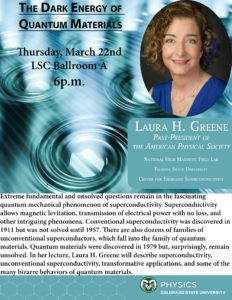Written by Julia Trowbridge
Laura Greene, past president of the American Physical Society and Chief Scientist at the National High Magnetic Field Laboratory, will give a free public talk at Colorado State University on Thursday, March 22 at 6 p.m. in the Lory Student Center Ballroom A.
 Greene’s talk, titled “The Dark Energy of Quantum Materials,” will be about the high magnetic field laboratory she works in, and what’s understood and not understood in the realm of superconductors.
Greene’s talk, titled “The Dark Energy of Quantum Materials,” will be about the high magnetic field laboratory she works in, and what’s understood and not understood in the realm of superconductors.
“I think the people who would get the most out of it are students who have a basic understanding of how materials work, but I think that everyone will find something interesting in it,” said Kate Ross, an assistant professor in physics and the event organizer. “It ties into the energy crisis, it ties into economics, so I think this is one of the most important problems in physics.”
High-temperature superconductors
Greene researches superconductors, specifically high-temperature superconductors, and the physics of these materials that isn’t yet understood.
A conductor is a material, like copper, that transmits charge, or electrons, between its atoms in order to create a current, which is what powers the technology we use today. Ordinary conductors have “resistance,” or force against the moving of these electrons, which comes from non-uniform scattering of the charges in the material as they are moving. This resistance inevitably creates energy loss when transmitting power, since it turns electrical energy into unwanted heat.
Superconductors, on the other hand, have no resistance, because the electrons are paired through quantum mechanical interactions in what is known as a Cooper pair. These Cooper pairs form a collective state that does not suffer from scattering. The drawback of these materials is that they only act as superconductors at low temperatures.
The so-called “high temperature superconductors” are a class of quantum materials for which the superconducting transition temperature is higher than for their well-understood counterparts. But even these only become superconducting below room temperature, requiring liquid nitrogen to cool them during operation.
“The big deal about this, is if we can understand the mechanism for unconventional superconductivity, we may be able to make a material with a transition above room temperature,” Ross said. “This would mean we could use superconductors for everyday applications like power transmission, or even transportation. But there are still a lot of things we don’t understand about high-temperature superconductors.’
Greene’s path to science
Greene became interested in science when she was young. Throughout her career, she fought the notion that women weren’t supposed to pursue science.
“I became interested in science the way most people become interested in science: you look at the stars as a kid,” Greene said.
In college, she took as many science classes as she could. She eventually earned her Ph.D. and continued to pursue her research at the postdoctoral, and then faculty level.
“Greene was actually one of the first people involved in measuring the properties of these high-temperature superconductors when that discovery hit,” Ross said. “She’s been in on unconventional superconductivity from the beginning.”
Greene was elected APS President last year, and spent her time working in science diplomacy, lobbying science both to the current government and to the international community.
“I started learning about science diplomacy, which is just a word for creating better climate, whether that’s resources or just getting to know people and understanding what we have in common,” Greene said. “And I realized that’s what I wanted to do. I want scientists to work together and to really bridge gaps in the world.”
Women and diversity in science
Greene saw that women weren’t encouraged to pursue science when they were young, especially when she was one of the few women in graduate school for science. This has grown into her passion for encouraging women and minorities to pursue science.
“I finally got myself educated on the importance of diversity, and that’s really one of my platforms of life: how important diversity is,” Greene said. “An example I use all the time is when the Americans and the Soviets started to work together in the 50s, and with just that amount of diversity, two different white guys from different backgrounds, changed the field of theoretical physics by collaborating.”
To increase the involvement of women in science, Greene works with a grass-roots organization called COACh, which advises and advances the careers of women in science across the world. Greene loves seeing the increase of women in science and the growing passions and careers of these women.
“I love doing that,” Greene said. “It’s really fun. And it’s fun when it’s not just young people, when more senior people are [at COACh sessions] also. You do what you can to promote diversity.”